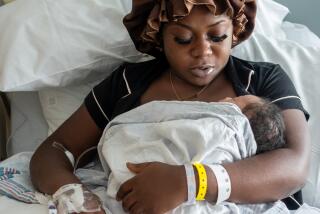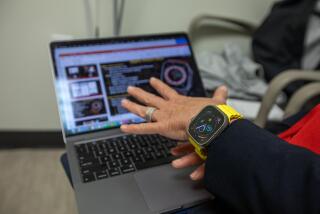Avoiding the Premature Birth as Way to Cut Risks
- Share via
A premature baby tethered to life support systems has become an increasingly common symbol of America’s front-line assault on infant deaths.
But that expensive, high-tech approach has major shortcomings, according to federal and private study groups who are calling for more emphasis on reducing the number of premature births.
Although $5 billion is spent annually on keeping premature infants alive in this country’s neonatal intensive care units, the United States has a higher death rate for babies in their first year of life than 18 other industrialized nations. Each year, 40,000 premature babies die within 12 months.
Four years ago, Tokos Medical Corp. in Santa Ana started marketing a service built around a device designed to help doctors prevent premature births.
“Our ultimate objective is to keep the baby in the womb,” said Tokos President Craig T. Davenport.
Central to the Tokos strategy is a miniaturized version of a monitor commonly used in hospital labor rooms. Its purpose is to detect signs of pre-term labor in a woman early enough for a physician to administer special drugs or change her activity to stall the birth process.
Twice-a-Day Monitoring
The monitoring, done twice a day, is intended for women who are considered to be at high risk for premature birth. They include women expected to give birth to two or more babies or those with a history of pre-term deliveries.
Dr. Michael Katz, an obstetrician/gynecologist at Childrens Hospital of San Francisco who developed the contraction monitor for Tokos and co-founded the company, said prematurity is responsible for 85% of the deaths of newborns. It also is reason for half of the neurological handicaps, ranging from cerebral palsy to mental retardation, that develop in the first few years of life, he said.
Katz contends that money spent on reducing infant mortality has been misdirected in the United States.
“The money has gone into developing a better nursery instead of making the womb a better nursery,” he complains.
The Tokos monitor is strapped around a pregnant woman and records information about uterine contractions. Those contractions, which can signal the onset of labor, often cannot be felt by the women.
The monitoring is done one hour in the morning and one hour in the evening, which are considered the periods of least and most frequent contractions, respectively. Each morning, the patient transmits the information over a telephone line to a nurse seated at a computer terminal screen that displays contractions as peaks on a horizontal line. At any sign of trouble, she alerts the patient’s doctor.
After it introduced its monitor, Tokos attracted several smaller competitors with similar devices. One of those is CareLink in Laguna Hills, which introduced a pregnancy monitoring service last summer.
None of the companies will disclose sales. But Dick Miles, vice president of corporate sales for Healthdyne Inc., an Atlanta firm that markets a pregnancy monitoring service, estimated that the industry’s combined annual sales have mushroomed to about $60 million in just 4 years.
Yet the industry’s expansion has been difficult, the major barriers being cost and debate over the effectiveness of the monitoring hardware.
The federal Food and Drug Administration and the American College of Obstetricians and Gynecologists say they are not convinced that the monitoring is any more effective than a patient’s close communication with a nurse, which is an essential component of the Tokos monitoring program.
Tokos officials say their monitoring service, which includes round-the-clock availability of nurse consultation, costs an average of $3,000 to $4,000 per patient, or $75 a day.
And advocates argue that the service is much less expensive than the alternative of maintaining a premature infant in intensive care for a month or more at a cost of $4,000 a day.
The FDA so far has refused to approve the uterine contraction monitor as an effective detector of pre-term labor because it contends that clinical tests of the monitor have been inconclusive.
So the FDA has said that Tokos may advertise the device only for monitoring full-term labor, a function for which similar monitors have traditionally been used in labor and delivery rooms of hospitals.
The FDA acknowledges, however, that it cannot constrain a doctor from prescribing a monitoring service for a woman at risk for premature labor. “If a doctor wants to use a device for that purpose, that is the practice of medicine,” said FDA spokesman David Duarte.
Pre-term monitoring technology has also failed to win the endorsement of the American College of Obstetricians and Gynecologists. “We have not seen any convincing data yet,” said Morton Lebow, a spokesman for the group.
Dr. John Morrison, chief of maternal fetal medicine at the University of Mississippi Medical Center, said he coordinated a large study in 1987 and 1988 that produced new data showing that about 45% of the effectiveness of the Tokos program can be attributed to the monitoring device. That data, he said, will soon be presented to the FDA as part of Tokos’ effort to win FDA approval of their monitor.
He said the recent study found that high-risk patients who received the service had 50% to 60% fewer early deliveries than women who adhere to the standard routine of visiting their doctors.
FDA reservations notwithstanding, an increasing number of physicians and insurance carriers are prescribing and paying for monitoring as a deterrent to premature births.
“Given that prematurity still accounts for 70% of the mortality of all newborn infants, it is reasonable to pull out all the stops to do whatever works,” said Dr. Thomas Garite, acting chairman of obstetrics at UCI Medical Center.
Declining to say whether the monitor or the nursing is the essential part of the the Tokos program, he said, “I am convinced the whole package works.”
Dr. Peter Anzaldo, a specialist in high-risk pregnancies who practices at St. Joseph Hospital in Orange, said that 4 years ago, about 70% of private insurance companies he dealt with were reluctant to reimburse for the Tokos service. Today, he said, 80% will pay for it.
“The bottom line is that it has helped to prevent pre-term labor and delivery,” Anzaldo said.
Tokos executives said they have gradually won over most health maintenance organizations and private insurers. Those insurers, however, are setting restrictive guidelines in deciding when the monitoring is warranted.
The most significant holdout, Tokos officials said, has been Medicaid, the government insurance plan for the indigent. Of 57 Medicaid organizations in the country that administer government-funded health care for the poor, only about a dozen have accepted the device, Davenport said.
Many government insurers, as well as the National Commission to Prevent Infant Mortality, have determined that limited medical funds would be better spent on providing the poor with increased access to prenatal care, drug education, good nutrition and the like instead of monitoring devices.
Computer-powered uterine contraction monitors should not be a priority, said Rae Grad, executive director of the national commission. “We are trying to get away from high-tech and back to the basics.”
Despite the obstacles, Tokos has expanded along with its business. The company has grown to 950 employees, including 400 registered nurses, working at 59 locations nationwide. The company’s headquarters in Santa Ana fill a 90,000-square-foot glass office building.
Janet Dunne is nurse administrator at the Tokos service center in Orange, where nurse stations are bedecked with snapshots of clients’ babies.
Three years ago, Dunne said, the center monitored about 50 women a day in Orange County, Riverside, Los Angeles, Arizona, San Diego and Hawaii. Today, she said, the center monitors 100 to 120 patients just in Orange County, Riverside and Hawaii. Additional monitoring centers have been set up to serve the other regions.
Jan Armando of El Toro was among the growing number of women using the monitoring devices last year. Because her first child was born 6 weeks premature, Armando’s doctor put her on the Tokos monitor when she was expecting her second child. When the monitor showed that she was going into labor 8 weeks early, she was immediately hospitalized and given medication that held off the birth for several weeks.
“I feel it relieved a lot of anxiety, and I feel it gave the baby a good chance at full maturity,” said Armando, whose daughter weighed in at 7 pounds, 6 ounces on Dec. 9.
Pieter Halter, a health-care specialist with Southern California Ventures in Newport Beach, said Tokos “is considered one of the best managed start-up companies. It has grown to be a success story.”
He attributed much of that success to Tokos Chairman and Chief Executive Robert F. Byrnes, who was formerly president of Caremark, a home health-care company, and vice president of sales, marketing and clinical research with Genentech, a biotechnology firm.
Byrnes declined to provide financial data about Tokos but said the company has been profitable since 1986 and will probably sell stock to the public next year.
Over the years, Tokos has diversified, adding a pharmaceutical service and home nursing program to provide at-home exams and intravenous therapy for pregnant women with such complications as diabetes or high blood pressure.
“Tokos has expanded far beyond monitors. It really is a full-service approach to managing high-risk pregnancies,” said Chuck Martin, general partner with Newport Beach-based Enterprise Partners, one of 6 venture capital firms that have invested in Tokos.
More to Read
Sign up for Essential California
The most important California stories and recommendations in your inbox every morning.
You may occasionally receive promotional content from the Los Angeles Times.













